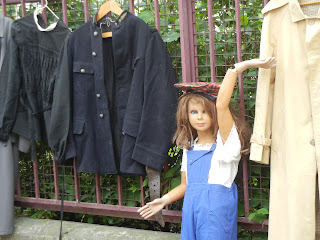I remember coming across Stravinsky hearing "Petrushka" one late night on the Erie public radio station while I worked all night with some grad students in the studio at Edinboro. While I love that piece on its own merits, it, too, has emotional and psychological attachments because of that memory. I minored in classical guitar performance while at Edinboro, in an attempt to understand the complexity of the guitar, which can always dish out more than I can eat. Some music majors sensed my curiosity (and lack of musical awareness) and turned me on to "The Firebird" and others. A grad student in painting who had studied with Meredith Monk told me that Stravinsky was arrested in Boston for an arrangement he composed of "The Star-Spangled Banner". I had a hard time 'hearing' Stravinsky, but later developed an appreciation for him past "Petrushka".
 |
| Igor Stravinsky in the 1920's |
I had watched a documentary on Coco Chanel last summer in one of these 'tailgating' sessions and remembered they had had an affair. I had already watched (and loved) "Coco before Chanel" because of my love for Audrey Tautou and purchased "Coco Chanel and Igor Stravinsky". Here's the trailer if you haven't seen it yet:
Trailer
Stravinsky would spend time each year in Switzerland and then return to Russia. Due to the Russian Revolution that was no longer possible and the family moved to Brittany. Money was tight despite his early success of "The Firebird". Chanel heard of Stravinsky's financial difficulties and extended an offer to him to move into her chateau, "Bel Respiro", in a suburb called Garches, here in Paris. I had hoped to get to see it, but it won't happen this trip. Stravinsky accepts, the family moves in, and shortly thereafter the affair begins.
http://www.youtube.com/watch?v=qB9vLJQhRgg
Before all of that begins, the movie recreates the famous rioting that occurred at Le Théâtre des Champs-Elysées in 1913- supposedly when Chanel first encounters his work. Le Sacre du Printemps' sheer volume of the orchestra (which apparently was massive), as well as the extreme unorthodox composition, both of music and dance, led to yelling and heckling, and then rioting, resulting in the police being summoned to get the crowd under control. Its surreal to think of this happening today. As I walked passed the Le Théâtre des Champs-Elysées (15 Avenue Montaigne, 75008 Paris)today,I couldn't help but think of the riot.
The Riot (around 3:00)
Apparently, Chanel was at the infamous debut of Le Sacre du Printemps, and in the movie, she seems to understand his genius in a way that the mainstream cannot, or is not ready to. Perhaps, she identifies with him being ahead of his time, the way her designs were ahead of other clothing designers. I would also love to believe that No.5 is created in Grasse during their affair. I'm not sure how much of this is accurate. Regardless, the fire that ignites between these two intensely creative people is enormous.
 |
| Coco Chanel in the 1920's |
I was shopping in the Marais the other day and came across, Place de Stravinsky, and it got me thinking about the movie. Here are some pics of the pool and commissioned works based on Stravinsky's pieces.


























































